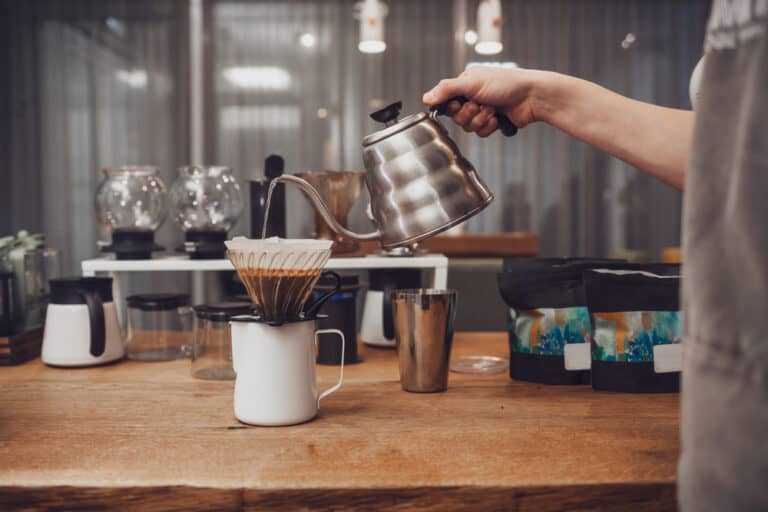
Update on the green coffee trade and its impact on our consumption
As a consumer of specialty coffees, you’ve undoubtedly noticed a surge in the price of your coffee bag over the last two years. Covid, market mechanisms, war… Why and how are we affected, and what do we need to prepare for?
Specialty coffee, separate from but dependent on the commodity market
Although outside the stock market system, it would be wrong to think that specialty coffee does not follow market economy mechanisms. Intermediaries, supply and demand and speculation are all part and parcel of the exchange of any commodity. Although we are not solely governed by these practices, we sometimes suffer their indirect consequences.
Over the past 20 years, the coffee market has seen trade rates well below production costs, thanks in particular to supply outstripping demand. For over two years now, the ratio has been reversing, with short rates rising exponentially to finally reach exchange rates that are liveable for the players.
Reduced production and increased demand are also to blame for the rise in prices, with manufacturers falling back on certain batches of specialty coffees to cover their needs.
A complex market
Apart from pure market economy mechanisms, crises can have a major impact on trade, whether in the very short term (disease on trees, loss of production following a climatic disaster, lack of manpower to harvest cherries, migratory crises, health crises, etc.) or in the medium and long term.
It’s always a good idea to find out about local market conditions and harvests in each country, so as to be able to judge the validity of the prices we’re being offered. They dictate prices as much as market mechanisms and batch quality.
For the same quality, batches from different countries or even regions can have huge price differences… for reasons that are entirely understandable. Knowing this means being aware of what is at stake for each terroir, and therefore supporting each of them to preserve the great diversity that makes our product so rich.
Ever-increasing costs
Whether at source, in transport, in processing… costs are increasingly high. Oil, water, electricity, gas, rents, labor costs, packaging… You don’t just pay for grain, you pay for all these things.
The current instability and inflation cannot fail to affect our industry. You continue to support the agri-food industry by going to the supermarket, but you should know that specialty coffee, working on small volumes, can’t break down these surcharges as well as the big industrialists.

What is “the right price”?
The right price is sustainability. The one that enables players to lead a life of descent and take action to perpetuate the business while taking action to protect the planet. I
There are far too few labels that guarantee these things (the big ones don’t), so it’s often wiser to ask about the traceability of the batch we’re buying to know the true impact of our choice.
Seasonality, quality, origin and additional costs (marketing being one of them, especially for the big chains or the kings of Google AdWords) all have an impact on the price of your coffee. Demand traceability for your batches and be curious consumers. In this way, the coffee industry can grow under the impetus of your virtuous demands.
For the year 2022, for example, a 250g bag of Brazilian Catuai nature with a cup score of around 83 costing over 10 euros could be considered expensive, but a Panamanian Geisha scoring over 89 at 35 euros for the same capacity would be considered a bargain. In coffee, as in wine, you have to go far beyond the price/content ratio.
What are the prospects?
Coffee professionals do not expect prices to fall over the next few years, and fear a reverse trend.
Personally, I’ve been predicting for years that consumers would have to face up to the reality of our product… a reality ignored by the majority of people for 80 years: coffee is not a commodity that can be consumed at will, it’s an exotic, tasty product.
Those who have made the switch to specialty coffee are already following this logic, and have seen prices rise, but less than industrial coffee, which is more subject to the storms of the mass market.
Today, we have achieved a decent level of remuneration for our players, and it is difficult to predict market fluctuations over the coming years. However, we can confirm that falling production, rising demand, inflation, global warming… are unlikely to push prices down.
The coffee business is no exception to the uncertainties, crises and challenges of the world around us. At a time when we’re experiencing a rarely seen increase in prices, it’s incumbent on us to ask ourselves the right questions today, in order to preserve this beverage that we love so much to enjoy and share.
The consumer’s responsibility is great, and often dictates the policies and actions of industry professionals. Now, more than ever, is the time to embrace this rise as something positive and an opportunity to consume coffee differently.
And since we don’t drink wine just to get drunk, we need to convey the idea that coffee is not a caffeine shot, but a product to be enjoyed, the result of the work of a large value chain that must be able to make a living from its work and have the necessary means to face the great challenges of our time and continue to delight us.

